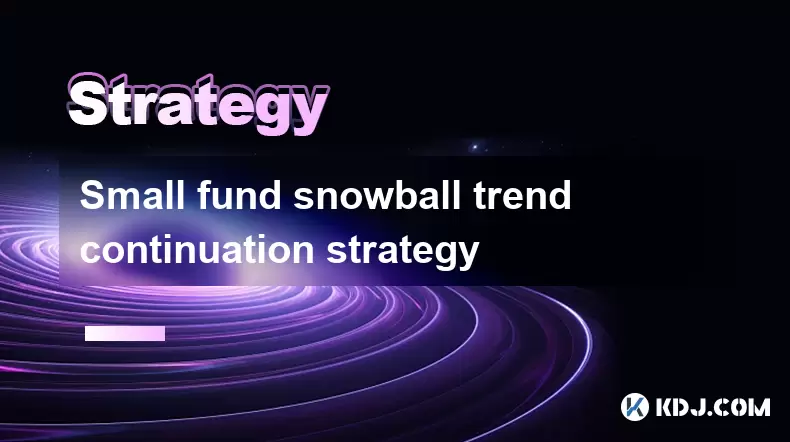-
 bitcoin
bitcoin $122288.232522 USD
0.16% -
 ethereum
ethereum $4480.662914 USD
-0.22% -
 xrp
xrp $2.962747 USD
-2.32% -
 tether
tether $1.000120 USD
-0.05% -
 bnb
bnb $1145.654223 USD
-2.07% -
 solana
solana $227.105217 USD
-1.67% -
 usd-coin
usd-coin $0.999548 USD
-0.02% -
 dogecoin
dogecoin $0.250875 USD
-2.04% -
 tron
tron $0.340654 USD
-0.49% -
 cardano
cardano $0.837968 USD
-2.52% -
 hyperliquid
hyperliquid $48.960449 USD
0.06% -
 chainlink
chainlink $22.049280 USD
-1.33% -
 ethena-usde
ethena-usde $1.000404 USD
0.02% -
 sui
sui $3.586212 USD
0.20% -
 avalanche
avalanche $29.894916 USD
-4.18%
Small fund snowball trend continuation strategy
The small fund snowball strategy leverages compounding to grow crypto portfolios, focusing on consistent reinvestment and selecting cryptocurrencies with strong fundamentals.
Jun 10, 2025 at 07:21 am

The small fund snowball trend continuation strategy is a popular approach within the cryptocurrency trading community aimed at capitalizing on small but consistent gains over time. This strategy focuses on leveraging small funds to build a larger portfolio through reinvestment and compounding, much like a snowball growing as it rolls down a hill. In this article, we will delve into the specifics of this strategy, its mechanics, and how traders can implement it effectively.
Understanding the Small Fund Snowball Strategy
The small fund snowball strategy is rooted in the concept of compounding returns. This means that instead of withdrawing profits, traders reinvest them back into their portfolio to purchase more assets. Over time, this reinvestment can lead to exponential growth, even if the initial gains are small. The key to this strategy is consistency and discipline in reinvesting profits and maintaining a long-term perspective.
Selecting the Right Cryptocurrencies
Choosing the right cryptocurrencies is crucial for the success of the small fund snowball strategy. Traders should focus on assets with strong fundamentals, consistent performance, and potential for long-term growth. Popular choices include established cryptocurrencies like Bitcoin (BTC) and Ethereum (ETH), as well as promising altcoins with solid use cases and development teams.
- Research: Conduct thorough research on the selected cryptocurrencies. Look into their whitepapers, development teams, and market performance.
- Diversification: Diversify your portfolio to spread risk. Instead of putting all your funds into one cryptocurrency, allocate them across several assets.
- Market Analysis: Keep an eye on market trends and news that could impact the price of your chosen cryptocurrencies.
Implementing the Strategy
To implement the small fund snowball strategy, traders need to follow a set of disciplined steps that ensure they are consistently reinvesting their profits and managing their portfolio effectively.
- Initial Investment: Start with a small amount of capital that you are comfortable investing. This could be as little as $100 or $200, depending on your financial situation.
- Trading Platform: Choose a reputable trading platform that offers low fees and a wide range of cryptocurrencies. Examples include Binance, Coinbase, and Kraken.
- Buy and Hold: Purchase the selected cryptocurrencies and hold onto them for the long term. Avoid the temptation to sell during short-term market fluctuations.
- Reinvestment: Whenever you realize a profit, reinvest it back into your portfolio. This could be done by purchasing more of the same cryptocurrency or diversifying into other assets.
- Monitoring: Regularly monitor your portfolio's performance. Use trading tools and charts to track the price movements of your cryptocurrencies.
Managing Risk
Risk management is a critical component of the small fund snowball strategy. Without proper risk management, even small losses can erode your portfolio's growth over time.
- Stop-Loss Orders: Use stop-loss orders to automatically sell your cryptocurrencies if their price drops below a certain threshold. This can help limit your losses.
- Position Sizing: Allocate only a small percentage of your total portfolio to any single cryptocurrency. This helps spread risk and prevents any one asset from significantly impacting your overall returns.
- Regular Reviews: Periodically review your portfolio and adjust your holdings as necessary. If a particular cryptocurrency is underperforming, consider reallocating those funds to a more promising asset.
Reinvestment and Compounding
The reinvestment and compounding aspect of the small fund snowball strategy is what drives its potential for long-term growth. By consistently reinvesting your profits, you can take advantage of the power of compounding to build a larger portfolio over time.
- Profit Reinvestment: Whenever you sell a cryptocurrency at a profit, use those funds to buy more cryptocurrencies. This increases your exposure to potential future gains.
- Dividend Reinvestment: Some cryptocurrencies offer staking rewards or dividends. Reinvest these rewards back into your portfolio to further enhance your compounding effect.
- Automated Reinvestment: Consider using trading bots or automated investment platforms that can automatically reinvest your profits according to your strategy.
Tracking and Adjusting Your Strategy
To ensure the small fund snowball strategy remains effective, it's important to track your progress and make adjustments as needed.
- Performance Tracking: Use a spreadsheet or a portfolio tracking app to monitor the performance of your investments. Record your initial investments, subsequent purchases, and realized profits.
- Strategy Adjustments: If certain cryptocurrencies are consistently underperforming, consider adjusting your strategy. This might involve selling those assets and reallocating the funds to more promising investments.
- Learning and Adaptation: Stay informed about the latest developments in the cryptocurrency market. Attend webinars, read articles, and engage with other traders to learn new strategies and adapt your approach as needed.
Frequently Asked Questions
Q: How much initial capital is needed to start the small fund snowball strategy?A: The initial capital required can be as little as $100 or $200, depending on your financial situation. The key is to start small and focus on consistent reinvestment of profits.
Q: Can the small fund snowball strategy be applied to other investment types outside of cryptocurrencies?A: While the strategy is designed for cryptocurrencies, the principles of compounding and reinvestment can be applied to other investment types, such as stocks or mutual funds. However, the volatility and unique characteristics of cryptocurrencies make them particularly suited for this strategy.
Q: How often should I reinvest my profits in the small fund snowball strategy?A: The frequency of reinvestment can vary based on your trading strategy and the performance of your portfolio. Some traders choose to reinvest their profits monthly, while others do so whenever they realize a certain percentage of gain.
Q: What are the risks associated with the small fund snowball strategy?A: The main risks include market volatility, potential losses if the chosen cryptocurrencies underperform, and the risk of not diversifying enough. Proper risk management and regular portfolio reviews can help mitigate these risks.
Disclaimer:info@kdj.com
The information provided is not trading advice. kdj.com does not assume any responsibility for any investments made based on the information provided in this article. Cryptocurrencies are highly volatile and it is highly recommended that you invest with caution after thorough research!
If you believe that the content used on this website infringes your copyright, please contact us immediately (info@kdj.com) and we will delete it promptly.
- BlockDAG, DOGE, HYPE Sponsorship: Crypto Trends Shaping 2025
- 2025-10-01 00:25:13
- Deutsche Börse and Circle: A StableCoin Adoption Powerhouse in Europe
- 2025-10-01 00:25:13
- BlockDAG's Presale Buzz: Is It the Crypto to Watch in October 2025?
- 2025-10-01 00:30:13
- Bitcoin, Crypto, and IQ: When Genius Meets Digital Gold?
- 2025-10-01 00:30:13
- Stablecoins, American Innovation, and Wallet Tokens: The Next Frontier
- 2025-10-01 00:35:12
- NBU, Coins, and Crypto in Ukraine: A New Yorker's Take
- 2025-10-01 00:45:14
Related knowledge

Practical parameter settings for a Bitcoin multi-timeframe moving average system
Sep 18,2025 at 10:54pm
Optimizing Timeframe Combinations for Bitcoin Trading1. Selecting appropriate timeframes is crucial when building a multi-timeframe moving average sys...

How can I filter out false breakouts in Dogecoin high-frequency trading?
Sep 22,2025 at 01:00am
Understanding False Breakouts in Dogecoin Trading1. A false breakout occurs when Dogecoin's price appears to move beyond a defined support or resistan...

Techniques for identifying tops and bottoms in the Bitcoin on-chain NVT model
Sep 20,2025 at 07:54pm
Understanding the NVT Model in Bitcoin Analysis1. The Network Value to Transactions (NVT) ratio is often described as the 'P/E ratio' of the cryptocur...

What does the surge in open interest in Bitcoincoin futures mean?
Sep 20,2025 at 11:18pm
Understanding the Surge in Dogecoin Futures Open Interest1. A surge in open interest within Dogecoin futures indicates a growing number of active cont...

How can I use the Ethereum USDT premium to gauge market sentiment?
Sep 18,2025 at 11:55pm
Understanding the Ethereum USDT Premium1. The Ethereum USDT premium refers to the price difference between USDT (Tether) traded on Ethereum-based plat...

What should I do if Ethereum staking yields decline?
Sep 20,2025 at 06:18am
Understanding the Causes Behind Declining Ethereum Staking Yields1. The Ethereum network transitioned to a proof-of-stake consensus mechanism with the...

Practical parameter settings for a Bitcoin multi-timeframe moving average system
Sep 18,2025 at 10:54pm
Optimizing Timeframe Combinations for Bitcoin Trading1. Selecting appropriate timeframes is crucial when building a multi-timeframe moving average sys...

How can I filter out false breakouts in Dogecoin high-frequency trading?
Sep 22,2025 at 01:00am
Understanding False Breakouts in Dogecoin Trading1. A false breakout occurs when Dogecoin's price appears to move beyond a defined support or resistan...

Techniques for identifying tops and bottoms in the Bitcoin on-chain NVT model
Sep 20,2025 at 07:54pm
Understanding the NVT Model in Bitcoin Analysis1. The Network Value to Transactions (NVT) ratio is often described as the 'P/E ratio' of the cryptocur...

What does the surge in open interest in Bitcoincoin futures mean?
Sep 20,2025 at 11:18pm
Understanding the Surge in Dogecoin Futures Open Interest1. A surge in open interest within Dogecoin futures indicates a growing number of active cont...

How can I use the Ethereum USDT premium to gauge market sentiment?
Sep 18,2025 at 11:55pm
Understanding the Ethereum USDT Premium1. The Ethereum USDT premium refers to the price difference between USDT (Tether) traded on Ethereum-based plat...

What should I do if Ethereum staking yields decline?
Sep 20,2025 at 06:18am
Understanding the Causes Behind Declining Ethereum Staking Yields1. The Ethereum network transitioned to a proof-of-stake consensus mechanism with the...
See all articles










































































